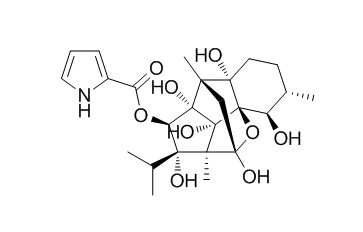Ryanodine
Ryanodine affects excitation-contraction coupling in skeletal and cardiac muscle by activation and inhibition of the Ca2+ release channel of sarcoplasmic reticulum.
Inquire / Order:
manager@chemfaces.com
Technical Inquiries:
service@chemfaces.com
Tel:
+86-27-84237783
Fax:
+86-27-84254680
Address:
1 Building, No. 83, CheCheng Rd., Wuhan Economic and Technological Development Zone, Wuhan, Hubei 430056, PRC
Providing storage is as stated on the product vial and the vial is kept tightly sealed, the product can be stored for up to
24 months(2-8C).
Wherever possible, you should prepare and use solutions on the same day. However, if you need to make up stock solutions in advance, we recommend that you store the solution as aliquots in tightly sealed vials at -20C. Generally, these will be useable for up to two weeks. Before use, and prior to opening the vial we recommend that you allow your product to equilibrate to room temperature for at least 1 hour.
Need more advice on solubility, usage and handling? Please email to: service@chemfaces.com
The packaging of the product may have turned upside down during transportation, resulting in the natural compounds adhering to the neck or cap of the vial. take the vial out of its packaging and gently shake to let the compounds fall to the bottom of the vial. for liquid products, centrifuge at 200-500 RPM to gather the liquid at the bottom of the vial. try to avoid loss or contamination during handling.
Functional Ecology2020, doi: 10.1111.
BMC Plant Biol.2023, 23(1):239.
South African J of Plant&Soil2018, 29-32
Appl. Sci.2020, 10(4),1304
Front Endocrinol (Lausanne).2020, 11:568436.
Life (Basel).2021, 11(12):1399.
Journal of Third Military Medical University2019, 41(2):110-115
Plant Direct.2021, 5(12):e372.
Int J Mol Sci.2022, 23(10):5468.
In Vitro Cellular & Developmental Biology - Plant2022, 58:972-988.
Related and Featured Products
American Journal of Physiology Cell Physiology, 1987, 253(3):C364-C368.
Ryanodine modifies conductance and gating behavior of single Ca2+ release channel.[Reference:
WebLink]
Ryanodine affects excitation-contraction coupling in skeletal and cardiac muscle by specifically interacting with the sarcoplasmic reticulum (SR) Ca2+ release channel.
METHODS AND RESULTS:
The effect of the drug at the single channel level was studied by incorporating skeletal and cardiac SR vesicles into planar lipid bilayers. The two channels were activated by micromolar free Ca2+ and millimolar ATP and inhibited by Mg2+ and ruthenium red.
CONCLUSIONS:
Addition of micromolar concentrations of Ryanodine decreased about twofold the unit conductance of the Ca2+- and ATP-activated skeletal and cardiac channels. A second effect of Ryanodine was to increase the open probability (Po) of the channels in such a way that Po was close to unity under a variety of activating and inactivating conditions.
The effects of Ryanodine were long lasting in that removal of Ryanodine by perfusion did not return the channels into their fully conducting state.
Journal of Agricultural & Food Chemistry, 1998, 46(6):2206-2210.
Multiresidue analytical procedure for insecticides used by organic farmers.[Reference:
WebLink]
A multiresidue procedure for the insecticides used by organic farmers has been developed.
METHODS AND RESULTS:
Rotenone, cevadine, and veratridine (the major components of sabadilla), pyrethrin I and pyrethrin II (the major components of pyrethrum), and Ryanodine and dehydroRyanodine (the major components of ryania) can be separated by high-performance liquid chromatography (HPLC) and detected and quantified by atmospheric pressure chemical ionization mass spectrometry (APCI/MS) in the selected ion monitoring mode. Piperonyl butoxide, a material sometimes used together with rotenone or pyrethrum to enhance toxicity, can also be detected and quantified by this procedure. The analytes are extracted with acetonitrile/water and are cleaned up with a C18 solid-phase extraction cartridge. Rotenone, piperonyl butoxide, and the two major sabadilla components could be detected (signal-to-noise ratio = 10) in lettuce, cucumber, and cabbage at 1-6 ppb.
CONCLUSIONS:
Pyrethrin I and the ryania components could be detected between 10 and 171 ppb in these vegetables, whereas pyrethrin II was generally less sensitive, with a limit of detection as high as 200 ppb in cabbage. Recoveries were in the 72-124% range. Percent coefficients of variation ranged from 2 to 17.
Journal of Biological Chemistry, 1986, 261(14):6300-6306.
Ryanodine activation and inhibition of the Ca2+ release channel of sarcoplasmic reticulum.[Reference:
WebLink]
METHODS AND RESULTS:
The effect of the plant alkaloid Ryanodine on the skeletal muscle sarcoplasmic reticulum Ca2+ release channel was studied by determining the Ca2+ permeability of "heavy" vesicles passively loaded with 45Ca2+ in the presence or absence of Ryanodine. Depending on the experimental conditions, Ryanodine either stimulated or inhibited Ca2+ efflux. Vesicles were rendered permeable to 45Ca2+ at a Ryanodine concentration of 0.01 microM when diluted into a medium containing the two Ca2+ release channel inhibitors Mg2+ and ruthenium red. At Ryanodine concentrations greater than 10 microM, 45Ca2+ efflux was inhibited in channel-activating (5 microM Ca2+) or -inhibiting (10 mM Mg2+ plus 10 microM ruthenium red) media. An optimal stimulatory effect was observed when vesicles were incubated with Ryanodine at 37 degrees C and in media that caused partial opening of the channel. Similar results to those described above were obtained using cardiac sarcoplasmic reticulum vesicles that were capable of rapid 45Ca2+ efflux. Use of the slowly permeating molecule L-[3H]glucose allowed measurement of channel-mediated efflux rates from vesicles in the presence and absence of Ryanodine. At low activating concentrations, Ryanodine did not appreciably change the regulation of L-glucose efflux rates by external Ca2+, Mg2+, and adenine nucleotide.
CONCLUSIONS:
These results suggested two possible modes of action of Ryanodine: 1) a change in the gating mechanism of the channel which is not readily detected using the slowly permeating molecule L-glucose or 2) a change in channel structure which prevents its complete closing.



